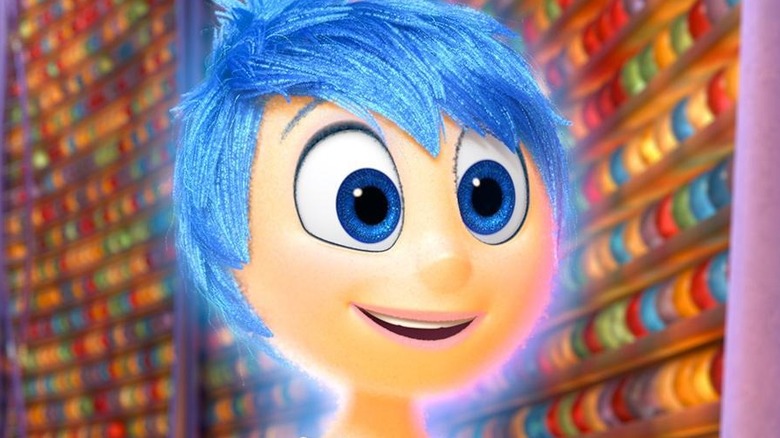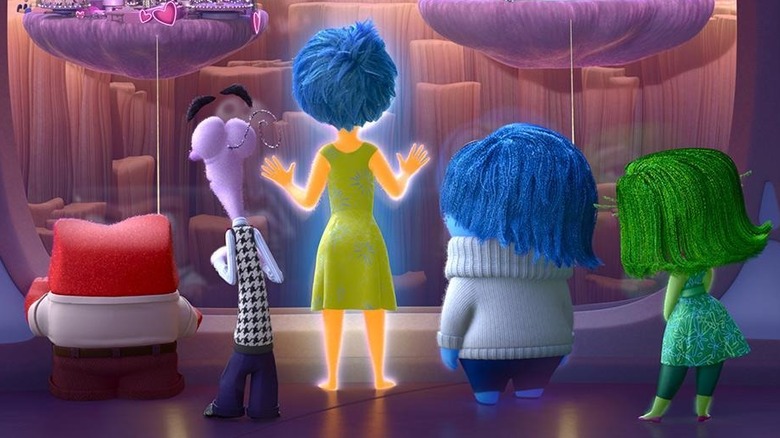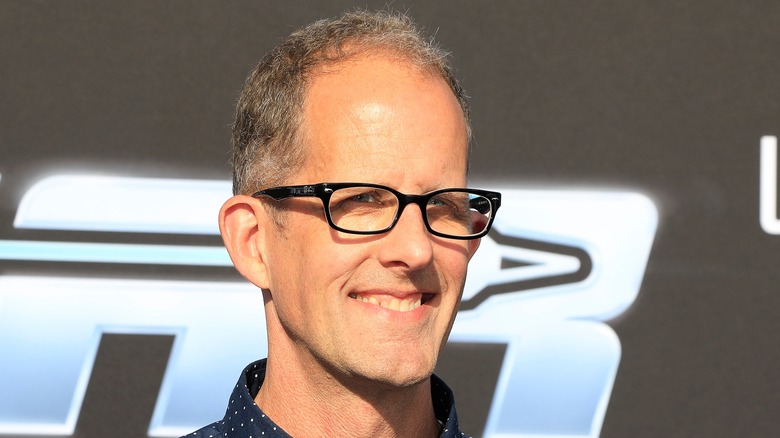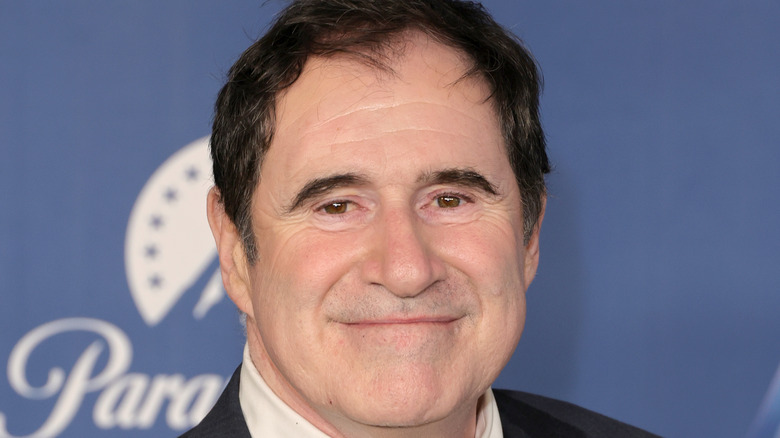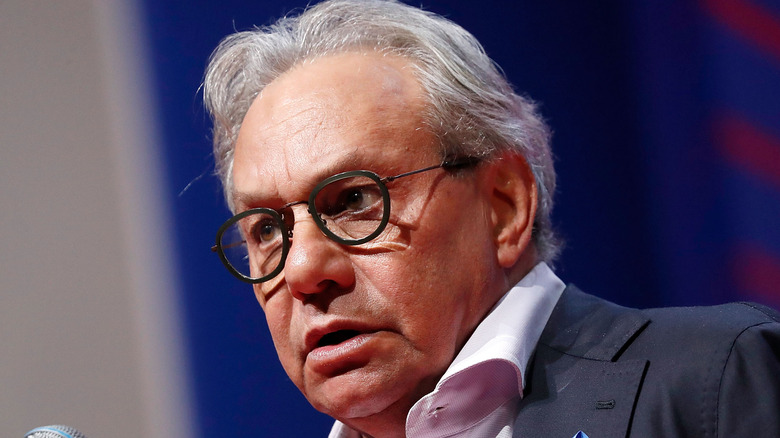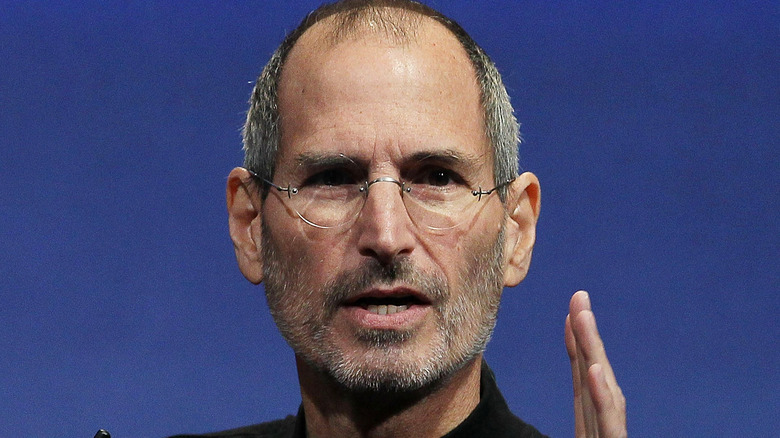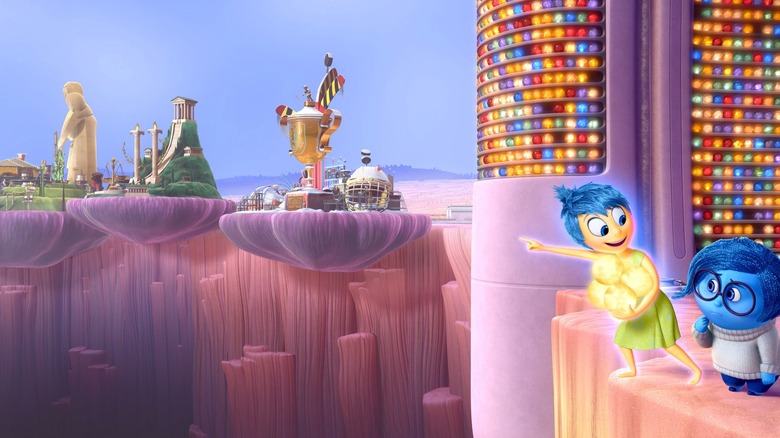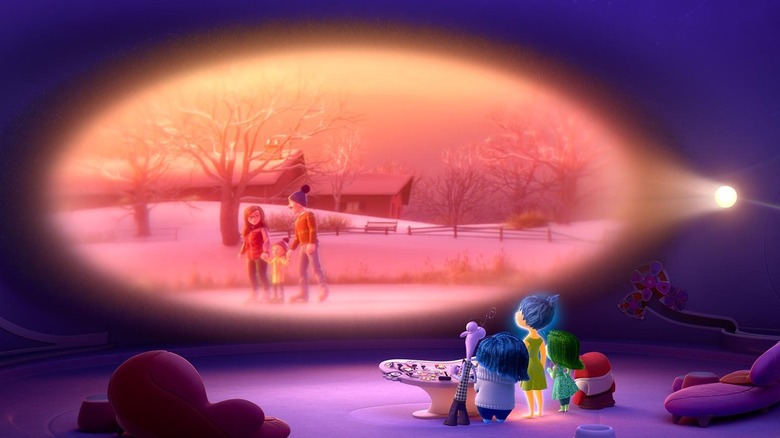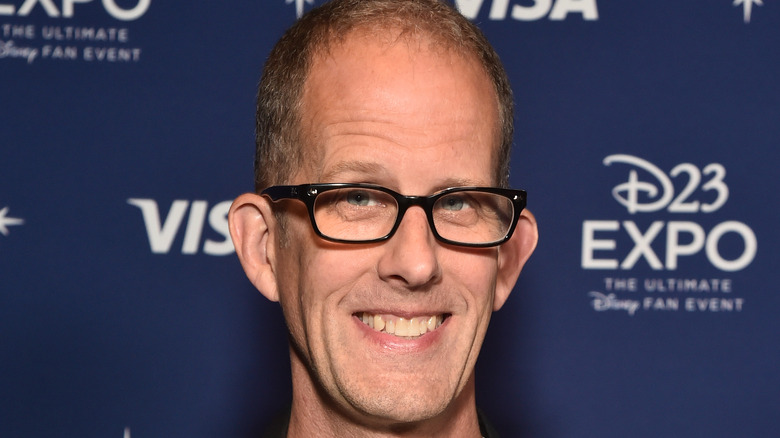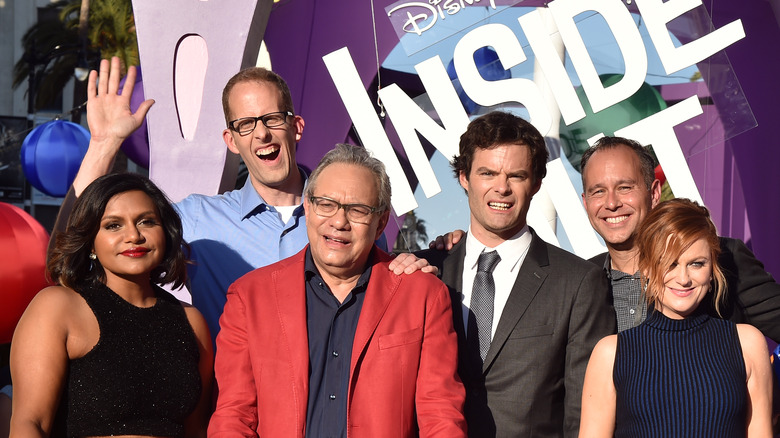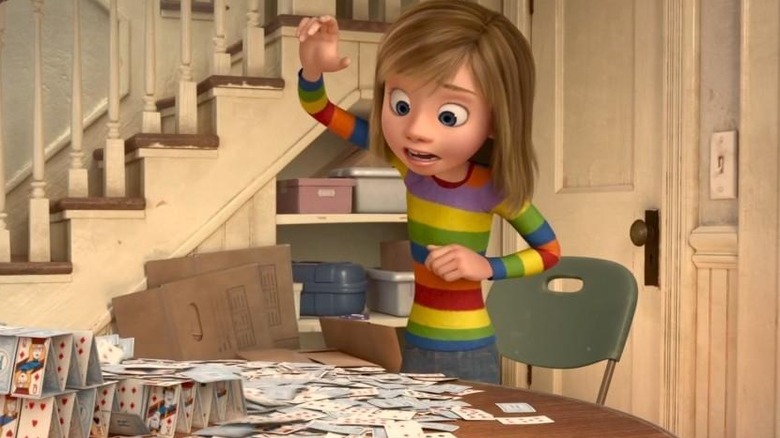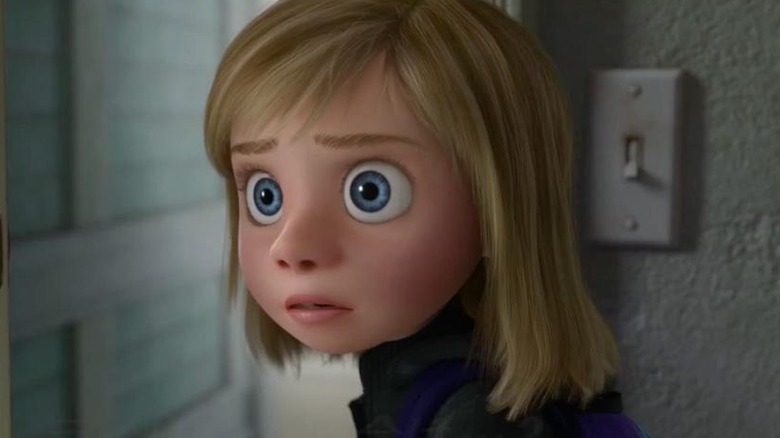The Untold Truth Of Inside Out
"Take her to the moon for me, okay?" These tear-jerking words come straight from one of the saddest scenes in Pixar's 2015 animated feature "Inside Out," a movie about a little girl dealing with the complex emotions of growing up as personified by characters like Joy, Sadness, Anger, Disgust, and Fear. The film resonated with both critics and audiences alike with its deeply relatable narrative, not to mention its healthy mix of laughs and tears, leading to a whopping 98% score on Rotten Tomatoes.
"Inside Out" was directed by Pixar veteran Pete Docter (who helmed "Monsters Inc.," "Up," and "Soul") and features a star-studded cast of performers such as Amy Poehler, Phyllis Smith, Bill Hader, Mindy Kaling, and Lewis Black as the five main emotions inside the head of a girl named Riley. The film went on to receive rave reviews and considerable accolades, including an Academy Award for Best Animated Feature at the 88th ceremony in 2016. It was also a massive box office success, with over $857 million in returns on a $175 million budget, showing that audiences around the world fell in love with the story and characters of "Inside Out." With a heartstring-pulling sequel on the way, it seems like the best time to learn everything you didn't know about the original.
Each emotion is shape-based
Since the main characters of "Inside Out" are embodiments of complex human emotions, simple physical designs were crucial for the film's story to work on a visual level. That's why the team at Pixar put a particular focus on making sure each emotion could evoke their personalities through the basic shapes of their character designs. Director Pete Docter went into detail about how the shapes and figures of the emotions were carefully thought out behind-the-scenes, telling USA Today in 2015, "This has been literally years and years of trying different things before we arrived where we did."
The movie's character art director, Albert Lozano, explained to The Hollywood Reporter that the team began the design process for the emotions by focusing on "basic simple shapes" before expanding beyond them. Joy is arguably the main character of the film (besides Riley herself), and her design is meant to resemble a star or sunburst of happiness to reflect her optimistic character. Sadness, naturally, started as a teardrop, while Anger began as a simple brick with fire spewing out of its head. Disgust and Fear were a little more complicated, with the two being based more on the looks of specific people rather than abstract objects. Disgust took some inspiration from characters like Aubrey Plaza's April Ludgate from "Parks and Recreation" (which, of course, starred Amy Poehler), while Fear was heavily inspired by the bulging-eyed look of characters like Mr. Bean and Barney Fife.
Pixar consulted experts on emotion
Pixar is known for doing their due diligence when it comes to research for their movies, and "Inside Out" was no exception to that rule. As a film dealing with some deep and complicated concepts as the emotions of adolescence and the workings of the human mind, the studio's storytellers knew they'd need a thorough level of forethought to do it all justice.
In a 2015 interview with NPR, Pete Docter went into detail about the types of experts who were brought in to flesh out the scientific side of human emotions for the story. "At the very beginning of this process, we realized, 'Man, we really don't know very much about this subject, so we better do some research,'" the director recalled. As a result, the team spoke to Dr. Paul Ekman, who believed there were six core emotions playing major roles in human development: anger, sadness, joy, fear, disgust, and surprise. Clearly, the Pixar team used this theory as a springboard, incorporating all of those into the plot of "Inside Out" (except for surprise, which was merged into fear).
Another consultant on the production was Dacher Keltner, a UC Berkeley professor of psychology who believes that sadness is a fundamental element of human bonding, and an essential way that people relate to each other through shared empathy. This philosophy was embraced by Docter and the writing team in a way that became the central conflict of the film through the relationship between Joy and Sadness, as well as Riley's eventual embracing of her own sadness regarding the move to a new home.
Bing Bong was kept a secret
One of the saddest moments in "Inside Out" comes from the character Bing Bong, an imaginary friend of Riley who has been forgotten as she's grown out of childhood. Played by Richard Kind (of "Mad About You" and "Curb Your Enthusiasm"), Bing Bong was brought to life through a mix of Kind's empathetic performance and the writer's sentimental approach to an imaginary friend who would do anything for his creator. Considering his importance in the movie, many may wonder why exactly Bing Bong was kept hidden from any official press before the movie came out. The answer is simple: surprise.
During an interview with Entertainment Weekly, Pete Docter was asked about the decision to keep Bing Bong hidden during the promotional campaign for "Inside Out." Keep in mind that the character wasn't mentioned in any art, interviews, or merchandise — there weren't even any official references to Richard Kind in the cast list ahead of time. Docter complimented his story team and the staff at Pixar, saying of the secrecy, "It was really smart move on our part, if I can pat ourselves on the back." With audiences not even expecting the character's entrance, they'd be even less prepared for his exit. Since Bing Bong's farewell scene has gone on to be one of the saddest in Pixar history for many fans (as discussions on Reddit will prove), it seems like their choice to keep it on the down low worked wonders.
Lewis Black was the first choice for Anger
Anger is one of the five core emotions in "Inside Out," seen as a character with a short temper and fiery personality (literally, since fire comes out of his head). He shares screen time with the other emotions while mostly playing a supporting comedic role in the story with frequent uncontrolled outbursts of rage that take control of Riley's mind. What you may not have known, however, is that the perfect voice for Anger was chosen a long time before the actor actually stepped into the recording booth.
Comedian Lewis Black was cast as Anger in "Inside Out," as he's known for his loud-mouthed comedy that relies heavily on rants and raves about all sorts of topics. Black became famous for his appearances on "The Daily Show" throughout the early 2000s, hosting a hilariously aggressive segment titled "Back in Black." Additionally, Black fostered a successful standup career with multiple specials over the years. It's because of his short-fused comedic reputation that he instantly came to mind when the filmmakers at Pixar began conceptualizing the character of Anger. This made slipping into the role an easy fit for Black, who told Den of Geek, "I went a lot with what was written because it was all based on me."
The first Pixar movie without Steve Jobs
Pixar has been around for a long time, and some might forget that its origins are intertwined with none other than Apple founder Steve Jobs (per slidebean). Jobs purchased the young animation studio from Lucasarts in the '80s and fostered the direction of the company away from hardware to focus entirely on the development of animated films. In fact, Pixar was consistently a financial burden for Jobs, requiring him to personally keep the company afloat with his own wealth out of his faith that the team would eventually create a bankable product — which they did, when "Toy Story" arrived in 1995.
What's important to realize, however, is that Jobs continued to have input on every Pixar film from then on, even after he sold the studio to Disney. Many leaders of the company's early days, including John Lasseter and Edwin Catmull, would go on record saying that Jobs was essential to the stewardship of Pixar, providing key opinions on the stories they were developing (via Biography). As the filmmakers revealed to The New York Times, "Inside Out" was the first movie Pixar made without any input from Jobs, as it didn't enter production until after his death in 2011.
Inside Out almost featured more emotions
While "Inside Out" ended up sticking with the core five emotions of Joy, Anger, Disgust, Sadness, and Fear, there were other emotions up for consideration early in the movie's production. Because of the discussions the development team had with scientists and experts, they actually drafted up a much larger list of emotions that could be personified inside the 11-year-old Riley's head.
Some of the emotions that ended up being cut from the film include Greed, Love, Hope, and Pride, just to name a few. There were also some more unusually named emotions that invoke very specific feelings, rather than broader concepts, such as Schadenfreude and Ennui. Ultimately, these emotions were seen as auxiliary to the core five, and their traits were essentially bundled into the characters we ended up seeing in the movie. Interestingly, Pixar and USA Today provided not just the story of these missing emotions, but some fascinating early development art.
Riley has memories of other Pixar movies
An important element of "Inside Out" is the idea of memories, and how crucial they are to our emotions. In the story, the emotions inside Riley's head are able to conjure memories at any time in the form of little glowing balls which can then be relived in detail. Every memory has associated emotions, color-coded with, for example, yellow for joy or blue for sadness, and several moments in Riley's life are seen through this narrative device. What's particularly strange is that in some of these memories, other Pixar movies can be seen.
While this may be more of a Pixar Easter egg than anything, it's still an interesting creative choice to place the studio's previous work into a library of treasured memories. In particular, throughout the halls of memory cores can be seen glimpses of the opening from "Up" in Riley's memory banks, which implies that she may have seen the movie in her lifetime. This would imply that some Pixar movies exist as movies within the universe of other Pixar movies, which would be pretty trippy. This also further complicates the elaborate "Pixar Theory" that has gained steam online, which posts that all the Pixar movies actually take place in the same universe, including apparent outliers like "Cars" and "Brave."
Inside Out was inspired by the director's kids growing up
"Inside Out" is a deeply emotional film, in more ways than one. It tells the story of a girl on the verge of adolescence who is struggling to deal with big life changes as a result. Her emotions themselves even struggle to interpret what's wrong with the person they're responsible for, and the heart of the story comes in a reconciliation with all the conflicting emotions you're feeling, even if they're sad sometimes. It's a beautiful message that was partly inspired by the director's own experiences watching his real-life daughter go through similar circumstances.
Director Pete Docter spoke candidly in an interview with The Washington Post back in 2015 about where certain ideas in "Inside Out" came from. He discussed how years before the movie came into existence, he started thinking about it because his daughter began shifting from a "happy, goofy spirit" to someone more reserved. He recognized those changes in his own childhood as well, in a time when his parents moved him from Minnesota all the way to Denmark, which is a detail that was brought into Riley's story in the film too (replacing Denmark with San Francisco). Ultimately, watching his children grow up instilled a single question into Pete Docter that became the heart of the movie: "What is going on inside their head?" Luckily, "Inside Out" attempts to answer that question with kindness, empathy, and a deeper understanding of what makes us human.
Mindy Kaling and Bill Hader cried after hearing the pitch
It should come as no surprise that a movie as emotional as "Inside Out" would cause even the people making it to feel some deep emotions of their own. What may be surprising is that just the pitch for "Inside Out" alone caused two of its main actors to start crying before they even got to work. In "Inside Out," Mindy Kaling and Bill Hader play the emotions of Disgust and Fear respectively, but the presentation that Pixar prepared brought entirely different emotions out of them.
Kaling and Hader both come from comedy backgrounds, with Kaling being best known for her time on "The Office" and "The Mindy Show," while Hader made his name on "Saturday Night Live." Although they've each had impressive careers in the entertainment industry, apparently their coming together for "Inside Out" was partly based on their emotional reactions to the story. According to an interview with Yahoo! Movies, Kaling and Hader were given a heartwarming PowerPoint presentation by Pete Docter that pitched the movie around his experiences with his own daughter. The team over at Pixar noted (per The Star) that while crying, Kaling said, "Just the fact that you're making a movie that tells little girls it's hard to grow up and it's okay to be sad about things, it's really profound."
Inside Out took five years to make
While "Inside Out" eventually became a critical and commercial success, the production problems it faced while being developed may have made that feel unlikely to the filmmakers at the time. It turns out that the movie took over five years to make from beginning to end, and proved to be very taxing on Pixar (via AP News). While it eventually earned prestigious accolades including an Oscar, a BAFTA, and a Golden Globe, it was undeniably a long road to get there.
Much of the talent behind "Inside Out" have been open about the difficulties they faced in creating the movie, with supervising animator Shawn Krause telling KPCC, "I think it's fair to say that was probably the toughest nut to crack as a film." Pete Docter also had to deal with the long development time for "Inside Out," and admits that at one point they even had to scrap everything they were working on and start fresh, three years in (via IndieWire). All in all, the fact that "Inside Out" turned out as good as it did seems like a wild bit of luck.
There's no antagonist by design
"Inside Out” is a story about the unseen conflicts that go on within our minds, but fans may have noticed that there's no real villain in the movie for the main characters to face off against. This was actually by design, as the creators developed a general sense of gloom to be the main antagonist of the story. Originally, as seen in "The Art of Inside Out" book (via Character Design References), there was going to be a noticeably dark cloud that grew larger as the movie went on, but this concept dropped in favor of simply having a gray color creep into the movie's palette as Riley's headspace gave way to despair.
It was noted by reviewers like Linda Holmes of NPR that "Inside Out" lacking a dastardly villain is a great choice for the story being told. As Holmes wrote, "Her great battle — the battle that must be fought by her Joy and her Sadness but is being fought by Riley always, after all — is simply to master the fact that her assembled life is delicate and complex." In many ways, this decision functions to let audiences relate to Riley even more as she defeats something less tangible but more real than a mustache-twirling villain through her emotional growth.
